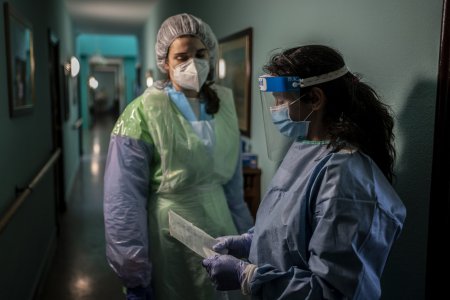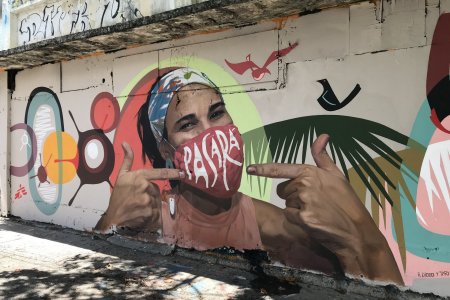
Covid-19 Reading List - Part 4
Michaël Neuman & Natalie Roberts
After a few months of respite the coronavirus epidemic has resumed its spread. With the second wave becoming a reality in many European countries, the Crash team decided to share some recent reading on the biomedical, political and social aspects of the pandemic in an attempt to shed some light on this tragic Season 2. As in previous editions, some articles are in English and some in French, and they are taken from both mainstream and specialist sources.
You can find the first reading list published in April, the second, published at the beginning of May, and the third, published at the beginning of July on our website.
1/ Transmission
A virus that is hardly any less of a novelty than it was a few months ago offers the opportunity for extensive scientific debate, and although it is becoming more familiar, its mechanisms and effects on the human body are still widely discussed.
The debates on airborne transmission continue, even if it is now generally accepted that a large part of the transmission is indeed carried out by airborne route.
An excellent infography by El Pais illustrates this mechanism of infection and the preventive measures that should be taken.
At the same time, the intense debate on the contagiousness of children and teenagers continues. In his blog Réalités Biomédicales, Marc Gozlan offers a very instructive inventory of the current state of affairs.
2 / Immunity
Questions regarding immunity and the functioning of the immune system in the face of the virus also remain at the heart of scientific discussions: what characterizes the encounter of this virus with the immune system? The New Yorker examines the attack of the virus on the immune system, while Lise Barnéoud for Médiapart looks at the mechanism of immunity. It would seem that the immune system is actually somewhat complicated... who knew?
A fascinating yet slightly frightening article in the South China Morning Post describes a mechanism that is feared could make a second infection by the virus even more serious than the first: the 'antibody-dependent enhancement'.
3/ Vaccines and treatment
From immunity, we naturally move on to vaccination, the great promise of the year 2021.
Le Vidal, via the pen of Stéphane Korsia-Meffre, offers us a review of the trials in progress.
The journal Nature also presents a slightly more technical but very complete article on the development of the most advanced vaccines against Sars-Cov-2. It is a text that is handily completed by this one from Science that outlines the different ways efficacy of these vaccines can be evaluated.
Director of studies at the CRASH and co-author of this list, our very own Natalie Roberts teams up with Nathalie Ernoult to discuss the implications of promoting the vaccine as a common good, highlighting the dangers of exaggerating the vaccine's importance, raising unrealistic expectations and creating political pressure in a piece published on our website.
Finally, we look at the potential of vaccines to benefit society on one hand, with an article from The Guardian - and to benefit industry on the other - with an article in The Financial Times, which describes the huge market that the coronavirus vaccine represents.
Because the vaccine is still only a promise, the race for treatments is also on.
Science magazine presents what could be a very bad look for Remdesivir: just a week after the EU signed a deal potentially worth $1 billion to purchase the antiviral Remdesivir, results of a large clinical trial managed by the WHO showed that the drug does not reduce mortality or the time COVID-19 patients take to recover.
Meanwhile, the promise of monoclonal and nanoclonal antibodies seems more interesting. Researchers are designing more advanced antibody treatments that could be cheaper, easier to produce and more potent, as Nature reports.
Finally, any Crash reading list on Covid-19 would be incomplete without a mention of chloroquine. In this article, a team of sociologists and science historians, including Arnaud Saint-Martin, respond to another sociologist, Laurent Muchielli, usually known for his work on delinquency and insecurity but now increasingly recognised for his bias in favour of Didier Raoult.
As we know, the current lack of effective targeted treatments and vaccines leaves us mainly with prevention, or rather 'non-pharmaceutical measures', and in particular with masks. This is an opportunity for us to plunge back into the science of masks, with this article from Nature in which we read: "You can't do randomised trials for everything - and you shouldn't." As clinical researchers are sometimes fond of saying, parachutes have never been tested in a randomized controlled trial, either.
(And if recalling that Raoult said precisely that about chloroquine, one can safely retort that swallowing pills and putting a piece of cloth on your face is not exactly the same thing)!
4/ Inequality
Epidemic practitioners know the importance of the social and unequal dimensions of epidemics. This has become clear to us once again, as illustrated here by two articles. The first, published in The Lancet, refers to Covid-19 not as a pandemic but as a syndemic.
Two categories of disease are interacting within specific populations—infection with severe acute respiratory syndrome coronavirus 2 (SARS-CoV-2) and an array of non-communicable diseases (NCDs). These conditions are clustering within social groups according to patterns of inequality deeply embedded in our societies. The aggregation of these diseases on a background of social and economic disparity exacerbates the adverse effects of each separate disease.
The second summarises a study of epidemiology and living conditions that took place in France in May 2020. It addresses the issue of inequality from two angles: on the one hand, the exposure to the virus linked to the place of residence, housing conditions or the need to work away from home; on the other, the effects of confinement on living conditions: remote working, childcare, and employment and financial situation.
5/ Covid and crisis management
We move to consider the response to the epidemic in France, Switzerland, New Zealand and Africa.
In France, sociologists from the Centre for the Sociology of Organisations (Sciences Po / CNRS) highlight the structural dysfunctions of bureaucratic organization in an interview with the magazine Usbek Et Rica.
In Switzerland a clear political choice, for which responsibility is not overtly assumed, is examined in this article in Foreign Policy. We also take a look at New Zealand, where being an island makes a pandemic considerably easier to control at a national level, but it is nevertheless interesting to look at the strategy determined by the country’s government that has enabled them to defeat the virus, at least temporarily, as Marc Gozlan explains in his blog.
Noting that Africa has been less hard-hit than other continents, Nanajala Nyabola reflects on how the issue of the continent's assumed vulnerability has been addressed.
At a time when the management of the epidemic continues to be a matter of debate, the question of consultations (or lack thereof) of veterinarians’ expertise also seems interesting. This is the argument of two (1 & 2) interviews published in the newspaper Le Monde.
We also discuss the trajectory of epidemics, starting with How Epidemics End, an essay on the history of epidemic endings and how they’ve taken many forms, with only a handful of them having resulted in the elimination of a disease.
And finally, a bit of radio, with a fascinating radio documentary from France Culture on the fantasy of epidemics in the West.
We wish you all a pleasant read!
To cite this content :
Michaël Neuman, Natalie Roberts, “Covid-19 Reading List - Part 4”, 20 novembre 2020, URL : https://msf-crash.org/en/blog/medicine-and-public-health/covid-19-reading-list-part-4
If you would like to comment on this article, you can find us on social media or contact us here:
Contribute




Add new comment